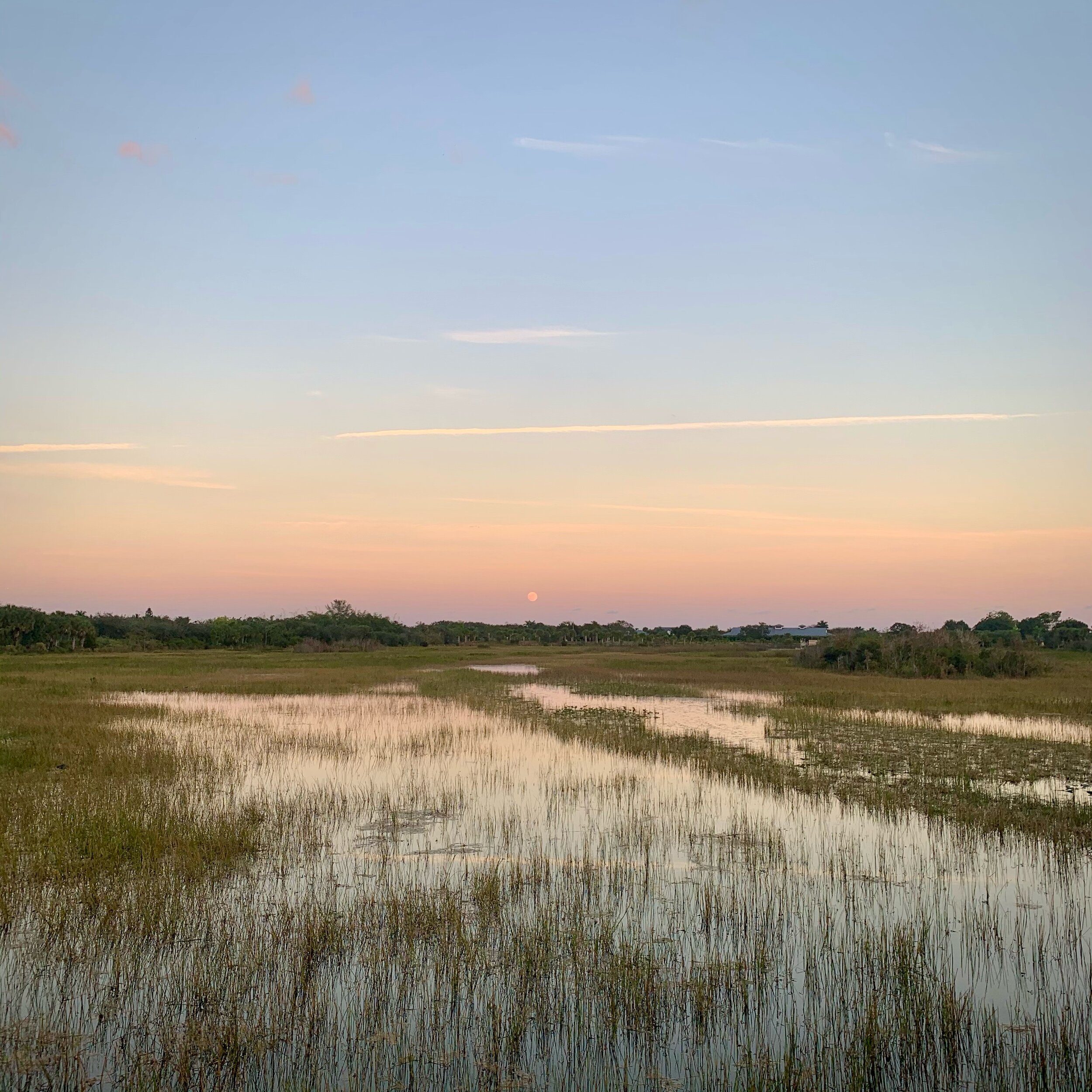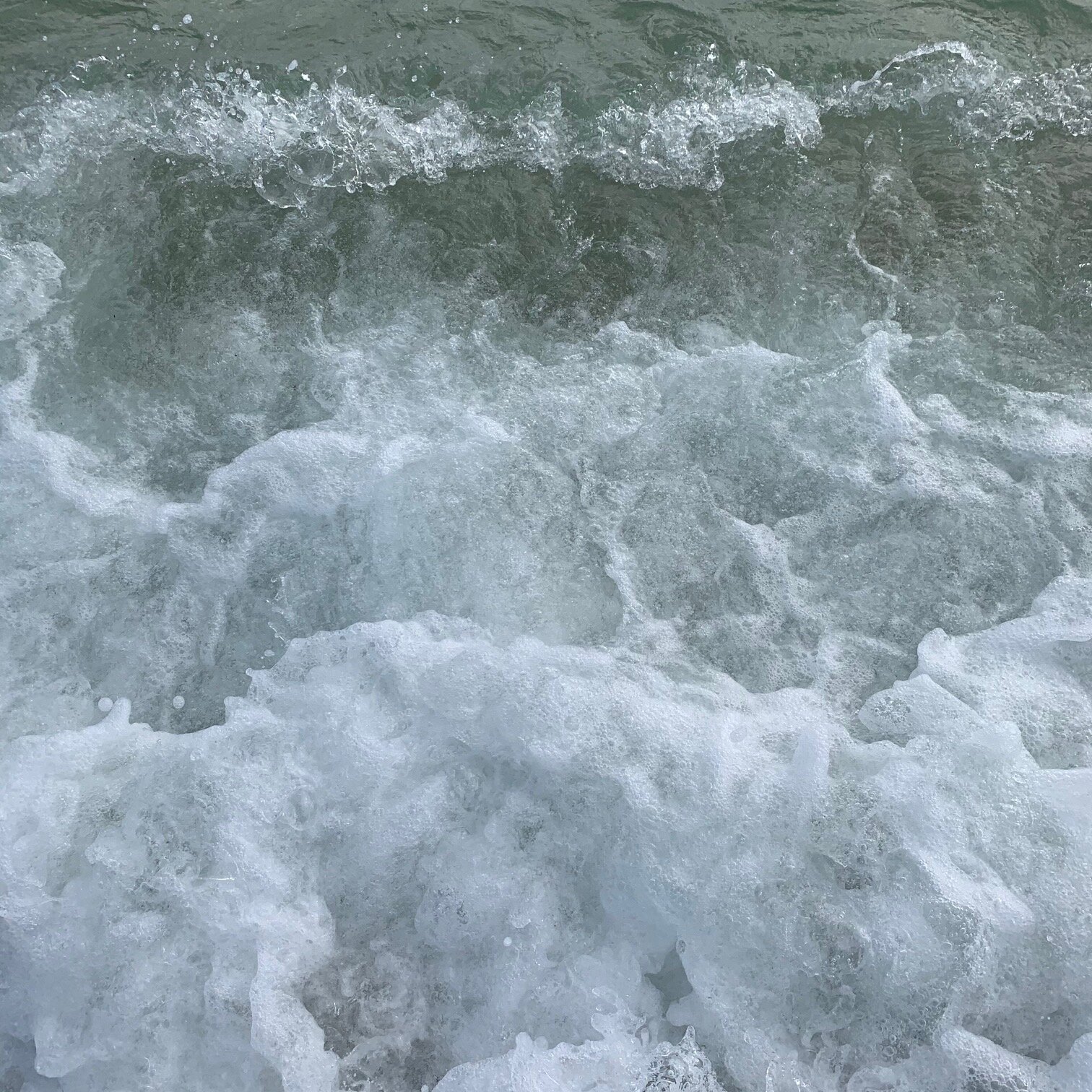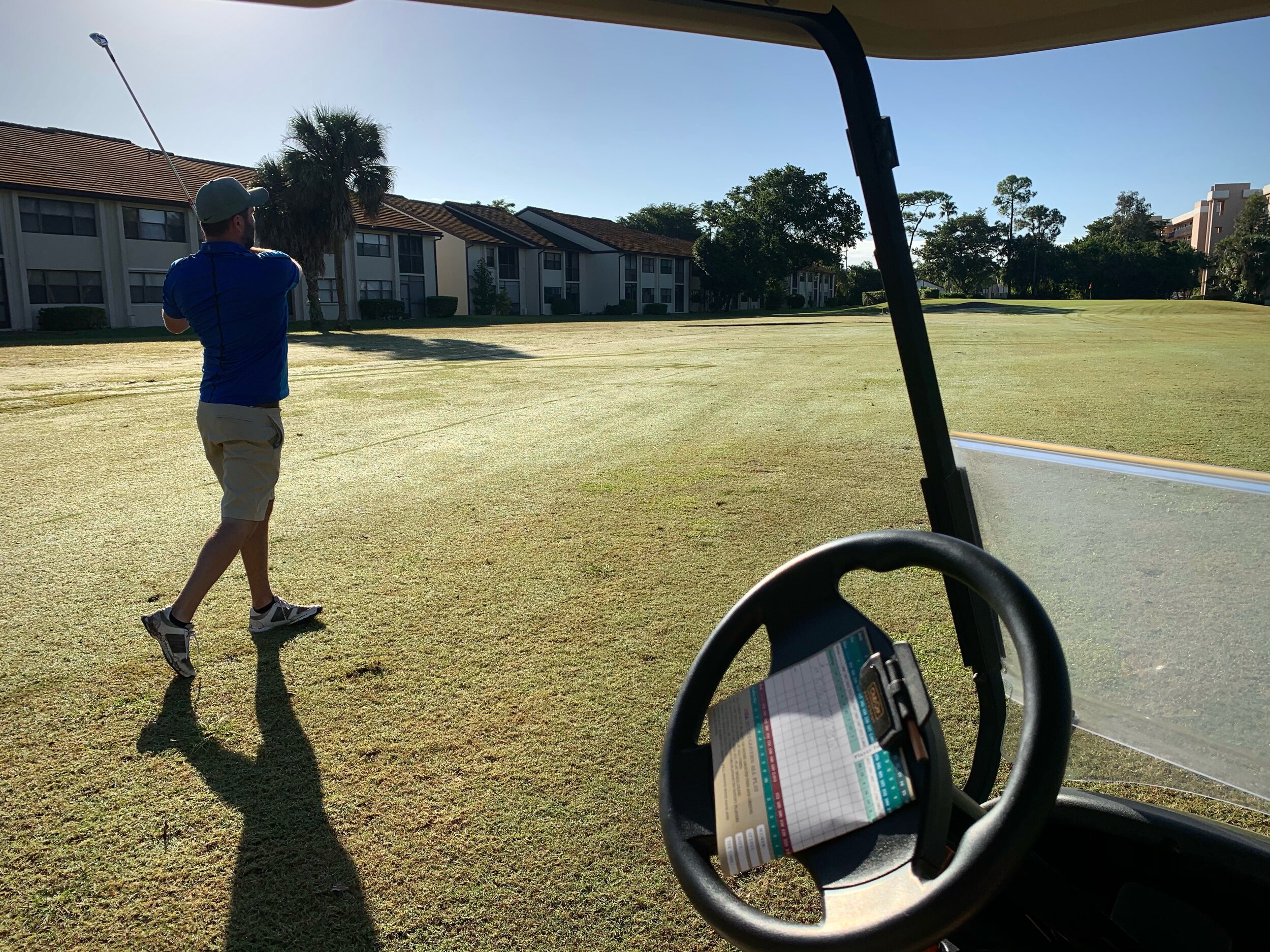One spot that I visited twice while In Florida is called the Wellington Environmental Preserve. It’s part of a system to filter the water from Wellington before it enters the Everglades, which I was told starts in this area and extends all the way to the coast. There are two long boardwalks over the water that allow you to get much closer to fish, birds, and alligators than you would otherwise. A five-story tower offers a great view of the whole property and beyond. One new bird I spotted was a solitary Wood Stork. And as I was leaving at sunset, in the distance I think I saw two Sandhill Cranes but didn't have a chance to go back for a better look. I feel so fortunate to have had the opportunity to explore different natural areas in Florida while visiting my family!
Out To Okeechobee
How I wish that I had better photos to share all that I saw today. I went on a half-day road trip out west from Palm Beach to Lake Okeechobee. The most interesting moment was driving by a sugar cane field with 15 foot high flames, a monstrous plume of smoke you could see for miles, and an almost alarming amount of heat that wafted into my open window as I drove by. After doing some research I discovered how controversial it is. If you are curious there are two recent articles that I found at the Claims Journal and the Miami Herald websites. According to one article, there are 400,000 acres of sugar cane in Florida. Wow!
DuPuis Management Area, Canal Point, FL.
My first stop was the DuPuis Management Area where I went on a short hike. When I got there the parking lot was empty but upon leaving there was a gentleman resting against the map and information stand. Was not expecting to meet a retired motorcycle enthusiast taking a rest on his daily ride out in the country. We had a nice conversation and he recommended that I check out “the lock” just down the road. The lock helps maintain the water level for Lake Okeechobee, Florida’s 730 square mile Inland Sea, as boats leave or enter the canal to and from the lake. There’s a canal cut across the entire state to allow small boats passage. Turns out the Port Mayaca Lock & Dam is one of the few places you can get a good look at the lake since it is mostly hidden by a 40 ft. dike of earth and rock all along its perimeter. A historical sign next to a cemetery on the road to the lake gave a clue as to why such a large dike is necessary. In 1928 a storm surge broke through the then 6.6-foot dike and as many as 2500 people were killed.
Lake Okeechobee as seen from just south of the Port Mayaca Lock & Dam.
Being a farm photographer for so many years I now have a decent fascination for agriculture and get interested when I see farms and crops outside of my bubble. My route driving back toward the coast was somewhat random and it showed me two new types of farming I had not seen before. The sugar cane I mentioned already being the first. Found myself following a few semi-trucks with big caged trailers full of just harvested, and probably burned, sugar cane. The full ones heading towards a large industrial looking plant in the distance, and the empty ones heading back out for another load. No doubt a monolithic business.
The second type of farm I saw and was surprised by was turf. So many times I have seen a new housing development getting a delivery of pallets of grass to create someone’s new yard. Can’t say that I ever really thought about where it came from. As you can see from the picture below, there are literally 100’s of acres of mowed grass right next to the sugar cane fields. I watched as a specialized tractor cut up the strips of lawn and a few workers stacked it on pallets. One company’s website states they “offer muck-grown St. Augustine sod farmed on our fields throughout Western Palm Beach County.” Who knew!
Turf Farm along Old Conner’s Hwy heading southeast from Canal Point, FL., with a burning sugar cane field far in the distance.
Photos below: Top left- My trusty Mazda 3. Top right- Sugar cane field. Bottom right- The soil in this area is so very dark! Bottom left- If you’ve been to FL. you’ve seen the canals literally everywhere. They might be the reason this place is not all swampland.
A Walk Along The Ocean
The Atlantic Ocean as seen from Lake Worth Beach.
The Banyan Tree
Florida is lush with all kinds of plants and trees. Reminds me of California, where everything seems to be feeding on Miracle Grow and is so prolific and colorful compared with Texas and the rest of the country. The fact that it does not often get very cold here makes a big difference. Most of the state has either a tropical or humid subtropical climate. Maybe it’s not fair to say more lush but just different in a tropical kind of way. Different than what I’m used to for sure.
While visiting, one tree that I see every day while walking around my Aunt’s complex is what I believe to be the Banyan Tree (Ficus benghalensis), a member of the fig family. The reason I’m not confident of the exact species is that there is also a native Florida Strangler Fig (Ficus aurea) that looks similar. After quite a lot of research, I’m just not sure.
Banyans are mostly found on the other side of the world where they are native to the Indian subcontinent and are often considered sacred or magical, worshiped and venerated by many specific countries and religions.
Banyans are rated the largest trees on the planet according to the area covered, and they live for hundreds of years. I love noticing what is around me and then doing some research. There’s so much to learn and explore when you are naturally curious!
Golfing in Florida
The last time I went golfing was probably 3-4 years ago. And It was with the same cousin here in Florida. The only reason I know how to golf is from taking some lessons as a teenager at the YMCA in Pennsylvania while visiting my grandparents for the summer. Somehow those few lessons have stuck with me enough to be able to have a good time on the fairway and not totally fail every shot. Actually, there are a lot of experiences and lessons learned while visiting PA. from ages 11-17, starting when my parent got a divorce in 85’. How grateful I am to have been able to get to know and spend so much time with my grandparents on both sides. They are all gone now.
Saw some interesting wildlife on the course, and the weather was perfect. As far as birds go, there was the standard fare that you see almost anywhere in this part of Florida. Ducks, geese, coots, gallinules, and Ibis. The most prominent, raising big a ruckus at the 12th hole putting green, was around 20-30 Egyptian Geese. They’re really beautiful birds with a distinctive dark eye patch and overall attractive coloring. They originated in Africa and when brought over to the US for zoos and the like, got loose and established feral populations. According to Wikipedia, the Ancient Egyptians considered them sacred. It’s doubtful the golfers pay them much mind other than when the birds are honking loudly on the sidelines or a nearby roof, as the player tries to sink their final putt.
There were also some huge invasive green iguanas in trees and on the ground. They look like dinosaurs and are fairly docile but I know many people in this state do not like them and they can do a lot of damage. Not one of them ran out to grab any of my golf balls so I was happy. Overall a beautiful morning! I didn’t play too horribly and got some quality time with my cousin.
Day of Thanksgiving
I’m very thankful to be with my family on this day after a long stressful year. I’m thankful for all of the delicious food we consumed, and to every person that made having access to that food possible. From the farmer all the way to the grocery store employees, I hope they all are having a joyful day. Not everyone has food security and I don’t take it for granted.
If you haven’t read about the history of this holiday I recommend checking out the Wikipedia page. It seems like a given now, but the path it took to become a standard in the US is quite complicated. It definitely has grown out of many different religious traditions, but what I found most interesting was the time when it was more of a random or irregular event, based on the external circumstances of the world.
Me, my aunt, cousin, and his girlfriend.
“A day of thanksgiving was a day set aside for public worship in thanksgiving for events believed to signal God's mercy and favor. Such a day might be proclaimed by the civil authority or the church.” The counter or complement to that was something called a day of humiliation or fasting, which was more of a punishment connected to the judgment of God. “A day of humiliation or thanksgiving might be proclaimed in response to a drought, flood, fire, military defeat, or plague. They might also be held before the undertaking of a difficult endeavor.” Seems related to what’s happening now in many ways!
Fasting is something I’ve been researching and I think that’s why this part of history caught my eye. After stuffing myself to the brim with food today, the idea of less or limits appeals to me. I’m considering occasional fasts, to rest my system, and to work on a healthier relationship with food. Too often I eat without being hungry and for emotional comfort.
This train of thought also reminds me of a Stoic practice promoted by Tim Ferriss, from the Moral Letters to Lucilius, Letter 18, On Festivals and Fasting. “Set aside a certain number of days, during which you shall be content with the scantiest and cheapest fare, with coarse and rough dress, saying to yourself the while: ‘Is this the condition that I feared?” This is how my mind works.
Loxahatchee
This morning I put in almost 10,000 steps, slowly exploring the Arthur R. Marshall Loxahatchee National Wildlife Refuge. According to their website, “the refuge consists of 145,188 acres, or 226 square miles, of Everglades ecosystems including a mosaic of wet prairies, sawgrass ridges, sloughs, tree islands, cattail communities, and a 400-acre cypress swamp. These lands provide habitat — food, water, shelter, and space — for more than 250 species of birds, 60 species of reptiles and amphibians, 40 species of butterflies, and 20 types of mammals.” My main goal was bird watching, but I did happen to spot two alligators sunning on mud.
If you are interested, I will talk about the birds that I saw and anything notable while encountering them. The most prevalent and numerous were the Common Gallinule, American Coot, and Purple Gallinule. More than once I was startled by their alarming calls from the water line very near my path. When not reacting to me they were swimming around like ducks and eating vegetation from underwater. The Purple Gallinule reminded me of a very large pigeon in shape and the iridescent coloring of their feathers.
The largest birds descending in size were the Great Blue Heron, Great Egret, Anhinga, and Little Blue Heron. They were mostly out in the open and easy to observe. The Anhinga in particular really surprised me. I heard a splash and turned around to see 10 inches of its head above water, with a small fish skewered on the end of his upper bill. He then submerged for 10-15 seconds, came back up, and then seemed to disappear underwater, not to be seen again. It was hard to believe I was seeing a bird that stays underwater that much. Makes sense someone nicknamed it “Snakebird,” because that is how it looked.
There were a few birds that I was not able to identify. The more I get into birding the more I realize there is to learn. But when you love something and it is exciting the motivation is there. The last bird I will mention from this part of the refuge is the Loggerhead Shrike. What a handsome predatory songbird, mostly gray coloring, with black and white, and a precise mechanical song.
The Cypress Swamp at Arthur R. Marshall Loxahatchee National Wildlife Refuge.
The last area I visited was the 400-acre cypress swamp, a small vestige of its historical range before Florida was transformed into what it is today. It’s an area covered in shallow water, with Cypress Trees, ferns, Spanish moss hanging everywhere, lichens, and all other sorts of swamp plants. It was eerily quiet while I navigated the constructed boardwalk, and I imagined how it might be much more active and noisy at night. Just when I had about given up seeing any birds, I was surprised by the appearance of three different types of woodpecker in a matter of minutes. A Pileated Woodpecker, which always seems surprisingly large, a male and female Red-bellied Woodpecker pair, and what I think was a Yellow-bellied Sapsucker. What a great way to spend half my day!
Cormorant Haikus
Standing on my back
In the middle of the depth
Maybe I’m not real
We can make it work
Floating artificially
Rest for a minute
1300 Miles to Florida
Made it tonight to Florida for a few weeks visit with family. These pics are from this morning after camping(sleeping in my car) at Big Lagoon State Park. Was hoping to hike down to the ocean at sunrise, but most of the trails were closed due to hurricane damage. Still managed to get a glimpse. Stay tuned. I hope to be doing a lot of hiking and bird watching while here.
I’ll tell you more about my connection to the number 4 some other time. It’s pretty interesting.






















































